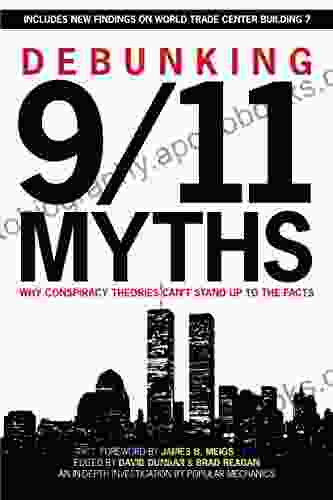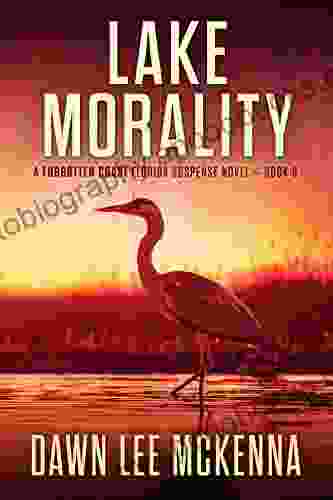Why Conspiracy Theories Can Stand Up To The Facts

Conspiracy theories have always been a part of human history, but in recent years they seem to be more prevalent than ever before. And while many people dismiss them as nonsense, there is actually a growing body of evidence that suggests that some conspiracy theories may have more truth to them than we realize.
4.3 out of 5
| Language | : | English |
| File size | : | 5813 KB |
| Text-to-Speech | : | Enabled |
| Screen Reader | : | Supported |
| Enhanced typesetting | : | Enabled |
| Word Wise | : | Enabled |
| Print length | : | 273 pages |
In his book, Why Conspiracy Theories Can Stand Up To The Facts, author Rob Brotherton argues that conspiracy theories are not always as irrational as they seem. In fact, he says, they can often be based on вполне реальных доказательствах. Brotherton cites a number of examples of conspiracy theories that have turned out to be true, such as the Tuskegee syphilis experiment and the MKUltra mind control program.
Of course, not all conspiracy theories are true. But Brotherton argues that it is unwise to dismiss them all out of hand. Instead, he says, we should be willing to consider the evidence and to ask ourselves whether or not there is any merit to them.
Brotherton's book is a fascinating and thought-provoking look at the phenomenon of conspiracy theories. He provides a thorough examination of the evidence for and against the most popular conspiracy theories, and he offers a nuanced and balanced view of this complex subject.
Whether or not you believe in conspiracy theories, Why Conspiracy Theories Can Stand Up To The Facts is a valuable book to read. It will challenge your assumptions about this topic and it will make you think about the world in a new way.
The Evidence for Conspiracy Theories
There is a growing body of evidence that suggests that some conspiracy theories may be more than just idle speculation. In his book, Brotherton cites a number of examples of conspiracy theories that have turned out to be true, such as:
- The Tuskegee syphilis experiment: In the 1930s, the U.S. Public Health Service conducted a study on the effects of untreated syphilis on African American men. The study was conducted without the informed consent of the participants, and it resulted in the deaths of hundreds of men.
- The MKUltra mind control program: In the 1950s and 1960s, the CIA conducted a series of experiments on human subjects in an attempt to develop mind control techniques. The experiments were conducted without the informed consent of the participants, and they resulted in psychological harm to many of them.
- The Watergate scandal: In the early 1970s, President Richard Nixon and his staff were involved in a cover-up of a break-in at the Democratic National Committee headquarters. The scandal led to Nixon's resignation and to the imprisonment of several of his aides.
These are just a few examples of conspiracy theories that have turned out to be true. There are many other examples that could be cited, and the evidence suggests that conspiracy theories are not as far-fetched as we might think.
Why Conspiracy Theories Can Be So Convincing
There are a number of reasons why conspiracy theories can be so convincing. One reason is that they often tap into our fears and anxieties. When we hear a conspiracy theory, it can resonate with us on a deep level. It can make us feel like we are part of something bigger than ourselves, and it can give us a sense of control in a world that often feels out of control.
Another reason why conspiracy theories can be so convincing is that they are often based on real evidence. As Brotherton argues in his book, there is a growing body of evidence that suggests that some conspiracy theories may be more than just idle speculation. When we hear a conspiracy theory that is supported by evidence, it can be difficult to dismiss it out of hand.
Finally, conspiracy theories can be so convincing because they are often presented in a way that makes them seem plausible. Many conspiracy theorists are skilled at using logical fallacies and half-truths to make their arguments seem more convincing. They may also use emotional appeals to play on our fears and anxieties.
How to Evaluate Conspiracy Theories
It is important to be able to evaluate conspiracy theories critically. Not all conspiracy theories are true, and some of them can be very harmful. It is important to be able to distinguish between valid conspiracy theories and those that are not.
Here are a few tips for evaluating conspiracy theories:
- Consider the source. Who is making the claim? Are they a credible source? Do they have an agenda?
- Look at the evidence. Is there any evidence to support the claim? Is the evidence credible? Is it biased?
- Consider the motivations. Why is the person making the claim? Are they trying to sell something? Are they trying to gain attention? Are they trying to push a political agenda?
- Be skeptical. Don't believe everything you hear. Question everything. Be willing to challenge the claims that are being made.
It is also important to remember that just because a conspiracy theory is not proven to be true, it does not mean that it is false. It is possible that there is evidence to support the theory, but that the evidence has not yet been found. It is also possible that the theory is true, but that it is being suppressed by powerful interests.
Conspiracy theories are a complex and fascinating phenomenon. They can be based on real evidence, and they can tap into our fears and anxieties. It is important to be able to evaluate conspiracy theories critically, and to be able to distinguish between valid conspiracy theories and those that are not.
Why Conspiracy Theories Can Stand Up To The Facts is a valuable book to read for anyone who is interested in this topic. It provides a thorough examination of the evidence for and against the most popular conspiracy theories, and it offers a nuanced and balanced view of this complex subject.
4.3 out of 5
| Language | : | English |
| File size | : | 5813 KB |
| Text-to-Speech | : | Enabled |
| Screen Reader | : | Supported |
| Enhanced typesetting | : | Enabled |
| Word Wise | : | Enabled |
| Print length | : | 273 pages |
Do you want to contribute by writing guest posts on this blog?
Please contact us and send us a resume of previous articles that you have written.
 Book
Book Novel
Novel Page
Page Chapter
Chapter Text
Text Story
Story Genre
Genre Reader
Reader Library
Library Paperback
Paperback E-book
E-book Magazine
Magazine Newspaper
Newspaper Paragraph
Paragraph Sentence
Sentence Bookmark
Bookmark Shelf
Shelf Glossary
Glossary Bibliography
Bibliography Foreword
Foreword Preface
Preface Synopsis
Synopsis Annotation
Annotation Footnote
Footnote Manuscript
Manuscript Scroll
Scroll Codex
Codex Tome
Tome Bestseller
Bestseller Classics
Classics Library card
Library card Narrative
Narrative Biography
Biography Autobiography
Autobiography Memoir
Memoir Reference
Reference Encyclopedia
Encyclopedia Aldo Madariaga
Aldo Madariaga Alan G Heath
Alan G Heath Hal Brunson
Hal Brunson Julie Jaffee Nagel
Julie Jaffee Nagel Russell Banks
Russell Banks Carol Shinn
Carol Shinn Alan Whelan
Alan Whelan Muriithi Wanjau
Muriithi Wanjau Aimee Nezhukumatathil
Aimee Nezhukumatathil Amy Michelle Mosier
Amy Michelle Mosier Donald Rapp
Donald Rapp Sharon Chen
Sharon Chen Dennis Barker
Dennis Barker Kevin Mclaughlin
Kevin Mclaughlin Fred W Frailey
Fred W Frailey Charlotte E English
Charlotte E English Ben Young
Ben Young Alesa Lightbourne
Alesa Lightbourne Pippa Lux
Pippa Lux Rosie Walsh
Rosie Walsh
Light bulbAdvertise smarter! Our strategic ad space ensures maximum exposure. Reserve your spot today!

 Ryūnosuke AkutagawaA Journey of Love, Sicily, and Finding Home: A Memoir of Transformation and...
Ryūnosuke AkutagawaA Journey of Love, Sicily, and Finding Home: A Memoir of Transformation and... Richard WrightFollow ·4.5k
Richard WrightFollow ·4.5k Emilio CoxFollow ·19.8k
Emilio CoxFollow ·19.8k Thomas PynchonFollow ·6.8k
Thomas PynchonFollow ·6.8k Lucas ReedFollow ·12.7k
Lucas ReedFollow ·12.7k Bryan GrayFollow ·2.1k
Bryan GrayFollow ·2.1k Reed MitchellFollow ·2.5k
Reed MitchellFollow ·2.5k Jamie BellFollow ·8.4k
Jamie BellFollow ·8.4k Nathan ReedFollow ·11.8k
Nathan ReedFollow ·11.8k

 W. Somerset Maugham
W. Somerset MaughamBach Dialogue With Modernity: A Journey Through Time and...
Prelude: Bach's Timeless...

 Ted Simmons
Ted SimmonsAsher Heroes At Heart Maryann Jordan: The Essential Guide...
Are you ready to...

 Paulo Coelho
Paulo CoelhoVienna Spies: Uncover the Hidden World of Espionage in...
Vienna has long...

 Herman Melville
Herman MelvilleThe Complete Guide to Orchestral Cymbal Playing:...
Step into the vibrant...

 Rubén Darío
Rubén DaríoEscape into a Holiday Haven with California Christmas...
Embark on a heartwarming and festive journey...
4.3 out of 5
| Language | : | English |
| File size | : | 5813 KB |
| Text-to-Speech | : | Enabled |
| Screen Reader | : | Supported |
| Enhanced typesetting | : | Enabled |
| Word Wise | : | Enabled |
| Print length | : | 273 pages |











